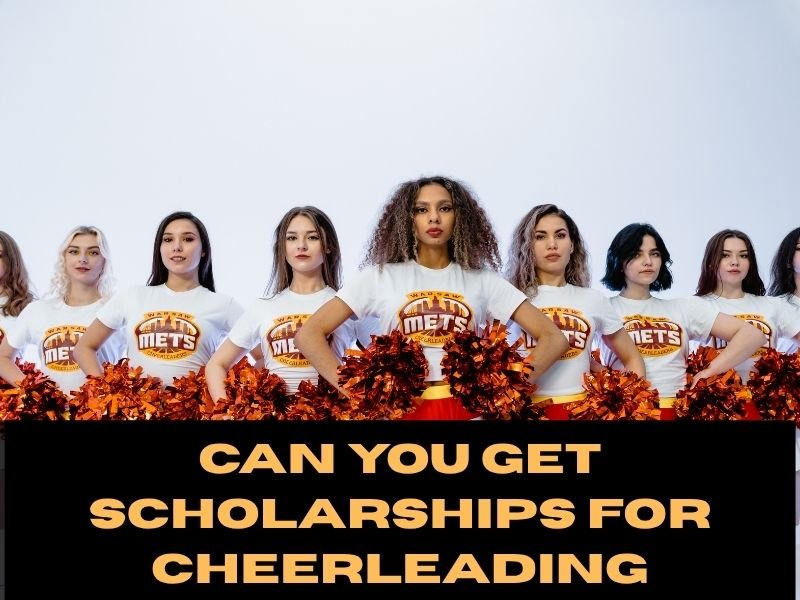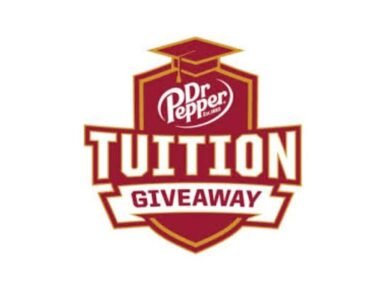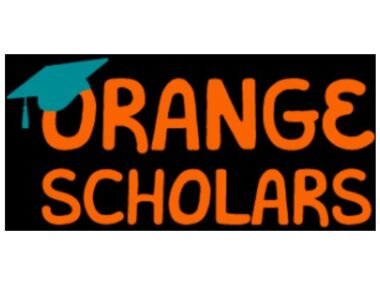Cheerleading is a vibrant, athletic, and energetic sport that blends dance, gymnastics, and teamwork. A frequent query among high school cheerleaders hoping to pursue their love in college is whether cheerleading scholarships are available. The answer is unquestionably yes! Cheerleading programs are offered by more than 250 universities in NCAA Divisions I, II, III, NAIA, and junior colleges; many of these programs give scholarships to help with tuition and other costs. However, obtaining these scholarships calls for expertise, planning, and preparedness.
This thorough 2025 guide will cover the answer to “Can You Get Scholarships For Cheerleading”, ranging from their various forms, eligibility requirements, how to apply for them, and practical advice to help you stand out. This article will assist you in navigating the process of using cheerleading to pay for your college education, regardless of whether you are a competitive cheerleader or a sideline enthusiast.
Are the scholarships for Cheerleading Available?
Scholarships for cheerleading do exist, but they are not the same as those for NCAA-approved sports like basketball or soccer. Compared to typical athletic scholarships, cheerleading frequently has less funding because it is not an officially recognized NCAA sport. Nonetheless, a lot of universities, particularly those with competitive cheer squads, set aside funds for cheerleading scholarships, which can range from partial tuition reimbursement to full-ride rewards in some situations.
Financial help for cheerleaders is also provided by other groups like the USA Cheer, the Universal Cheerleaders Association (UCA), and private scholarship websites like Bold.org. These scholarships, which are available to a broad spectrum of students, honor athletic prowess, academic success, leadership, or financial necessity.
The kind of cheering program determines the available scholarships. Because of their prominence and status, competitive cheer squads that compete in national championships like the UCA or NCA College Nationals frequently receive additional money. Smaller prizes or stipends may be offered by sideline cheer squads, which are devoted to promoting sporting events. Targeting the appropriate opportunities requires an understanding of these differences.
Cheerleading Scholarship Types
There are several types of cheerleading scholarships, each with its requirements and advantages. Below is a thorough explanation of the primary kinds:
College-Sponsored Scholarships: Students who make the squad through tryouts can get scholarships from several universities, which directly sponsor their cheerleading squads. For instance, 16 of the 21 cheerleaders at the University of Kentucky receive in-state tuition scholarships, which significantly reduces the cost for locals. These scholarships frequently call for extraordinary tumbling, stunting, and crowd-engaging abilities in addition to dedication to both academic and athletic obligations.
Private Scholarships: Cheerleaders can apply for scholarships from non-collegiate organizations like the American Association of Cheerleading Coaches and Administrators (AACCA) or websites like Bold.org. For example, Maryland students participating in extracurricular activities, such as cheerleading, are supported by the Sammy Meckley Scholarship on Bold.org. These grants, which usually run from $500 to $2,000, may give preference to leadership or community service.
Merit-Based Scholarships: Academic achievement is taken into account by many merit-based scholarships. Colleges such as Clemson University promote academic performance in addition to athletic brilliance by giving extra stipends to cheerleaders with the highest GPAs on the team. If you have a good GPA (usually 2.5 or above), you may be eligible for these combination awards.
Need-Based Scholarships: Certain initiatives provide financial assistance according on a student’s financial circumstances. Particularly at smaller universities or junior institutions like Bevill State Community College, these are sometimes paired with sports or merit-based rewards to produce all-inclusive aid packages.
Competition-Based Scholarships: Cheerleaders can receive scholarships directly from UCA, NCA, or USA Cheer if they do exceptionally well at national tournaments. For instance, the Christian Cheerleaders of America offer substantial financial support by giving out more than $1,000,000 a year to the best performances at their events.
What Is the Value of Scholarships for Cheerleading?
The school, the level of competition in the program, and the availability of financing all affect how much cheerleading scholarships are worth. A closer look is as follows:
Although they are uncommon, full-ride scholarships are offered by prestigious universities. For example, about 14 cheerleaders are eligible for full-tuition scholarships from the University of Hawaii at Manoa, which cover all of the costs of college for exceptionally talented athletes. Elite performers with exceptional tumbling and stunting skills are frequently the only ones eligible for these fiercely competitive honors.
Partial Scholarships: These are more prevalent and usually award between $500 and $2,500 per year. Depending on the program, they might pay for fees, books, or tuition. Belmont University, for instance, offers $1,000–$2,500 partial scholarships, depending on achievement and seniority.
Stipends and Perks: A lot of programs include non-cash advantages like free uniforms, reimbursement for travel costs to away games, or academic stipends for cheerleaders who perform well. Out-of-pocket expenses can be considerably decreased by these benefits.
The precise sum is determined by the cheerleader’s job (e.g., competitive vs. sideline) and the college’s budget. Because there is less competition in some programs, male cheerleaders might have an advantage in winning bigger prizes.
Which Universities Provide Scholarships for Cheerleading?
Cheerleading programs are offered by more than 250 institutions in the United States, with differing degrees of financial assistance. Scholarships are more likely to be offered by competitive programs because of their financing and notoriety, especially in NCAA Division I. An extensive list of prestigious universities with a reputation for granting cheerleading scholarships, along with descriptions of what each offers, can be found below:
- University of Kentucky (NCAA D1): Well-known for its competitive cheer squad that has won championships, Kentucky provides 16 of its 21 members with in-state tuition scholarships. Elite cheerleaders choose the program because it offers academic stipends to those who achieve high GPAs.
- University of Hawaii at Manoa (NCAA D1): This program attracts elite talent because of its competitive team and significant funding, and it grants full-tuition scholarships to about 14 cheerleaders. The curriculum places a strong emphasis on advanced tumbling and stunting techniques.
- Auburn University (NCAA D1): Auburn offers team players athletic scholarships that pay for travel, uniforms, and a portion of their tuition. Scholarship prospects are increased by competitive team’s repeated placements at national championships.
- According to seniority and skill, Belmont University (NCAA D1) grants partial scholarships that range from $1,000 to $2,500. Both competitive and sideline cheerleading are valued by the program.
- Bevill State Community College (NJCAA): Cheerleaders looking for competitive opportunities and an inexpensive education can apply for scholarships that cover books, tuition, and fees.
Visit NCSA Sports to locate additional institutions, or get in touch with cheer coaches personally to find out about tryout procedures and scholarship possibilities.
How to Apply for a Scholarship in Cheerleading
It takes a combination of academic success, physical prowess, and proactive outreach to land a cheerleading scholarship. Here are specific methods to increase your odds, along with an explanation of why each is important:
1. Gain Expertise in Cheerleading
Advanced-skilled athletes are given preference in college cheer programs, particularly competitive ones. Coaches want competence in:
- Flipping: For elite programs, standing back tucks, full-twisting layouts, or running tumbling passes are crucial. These abilities show adaptability and athleticism.
- Stunting: It’s essential to be able to execute intricate feats with several partners, such as extensions, liberties, or full-ups. Back spots, flyers, and strong bases are all in high demand.
- Dance: Showcase your versatility with advanced jumps, quadruple pirouettes, or aerials, particularly for presentations that feature a lot of dancing.
- Engagement of the Crowd: To enliven audiences, sideline cheerleaders must transmit their voices clearly and use precise motions.
Why It Matters: Whether in competition or at sporting events, coaches give preference to athletes who can make an instant impact on the success of their program. Cheer combines, like those organized by USA Cheer, provide you with the chance to show off your abilities to several coaches at once, which raises your profile.
2. Continue to Have a Good Academic Record
A lot of cheerleading scholarships are based on academic achievement. A GPA of 2.5 or more is frequently necessary, and some schools, such as Clemson University, give extra stipends to the team with the greatest GPA. Your application may also be strengthened by competitive ACT/SAT scores (such as 22/1110).
Well-rounded student-athletes who can successfully manage both academics and athletics must be highly valued by colleges. You can increase your financial aid package by becoming eligible for merit-based or combined scholarships if you have a great academic record.
3. Produce an Expert Hiring Video
- You have the opportunity to wow college coaches with a strong recruiting video. Incorporate:
- Both running and standing tumbling passes.
- To demonstrate adaptability, perform stunting sequences with several partners.
- Cheer shows and dance routines to showcase technique.
- highlights of the crowd-leading abilities displayed during tournaments or games.
- Make sure the film is well-made, brief (three to five minutes), and includes clear footage and labels for each ability. Distribute it by email or on websites such as NCSA Sports.
Why It Is Important: A unique video can help you stand out from the hundreds of requests that coaches receive. It increases your chances of being accepted to campus by showcasing your abilities and dedication before tryouts.
4. Participate in cheer camps and tryouts
Coaches assess abilities, teamwork, and program fit at tryouts, which are held at most institutions in the spring or summer. You can network with coaches, learn program-specific skills, and increase your visibility by going to college cheer camps or clinics.
Why It Matters: Camps allow you to establish relationships with coaches early on, and tryouts give you the chance to perform live. Camps are used by several institutions, such as Auburn University, to find possible scholarship winners.
5. Submit an External Scholarship Application
- Apply for private scholarships via websites such as Scholarships.com or Bold.org in addition to college-sponsored rewards. Among the examples are:
- Maryland students who participate in extracurricular activities, such as cheerleading, are supported by the Sammy Meckley Scholarship.
- The Knoxville Football Officials Association Scholarship gives cheerleaders from a few high schools in Tennessee a $2,000 award.
- At national competitions, the Christian Cheerleaders of America Scholarships award more than $1,000,000.
Why It Matters: You can lessen your financial load by using external scholarships to augment your education funding. They are a great chance because they frequently have less competition than college tryouts.
6. Examine Sideline vs. Competitive Programs
More scholarships are available through competitive programs like those at Navarro College and the University of Kentucky, but they also need exceptional talent and a strong commitment. Although side programs, such as those at smaller universities, may have more flexible skill requirements, they may grant lower prizes.
Why It Matters: By being aware of program expectations, you can more effectively choose universities that complement your objectives and skill set, improving your chances of receiving a scholarship.
The Difficulties of Applying for Scholarships in Cheerleading
Scholarships for cheerleading are available, but there are restrictions:
- Limited Funding: Cheerleading programs depend on university funds in the absence of NCAA sanctions, which may restrict the number of scholarships available.
- High Competition: Top talent is drawn to elite programs, which demand exceptional tryout performances and sophisticated skills.
- Cheer Cost: Even with scholarships, cheerleaders may still have to pay for camps, travel, or clothes if the program does not cover them.
Why It Matters: Being conscious of these obstacles aids in strategic planning, such as applying to several universities or looking for outside scholarships to assist in defraying expenses.How to Make Your Scholarship Application Stand Out
Take into account the following tactics to increase your chances of receiving a cheering scholarship
- Emphasize Leadership: In your application or recruitment video, highlight positions such as team captain or event coordinator. Leaders who can motivate their team are highly regarded by coaches.
- Showcase Versatility: To appeal to both competitive and sideline programs, exhibit skill in dance, tumbling, stunting, and crowd interaction.
- Write a Strong Essay: For private scholarships, write a personal essay discussing how your ambitions, work ethic, or character have been influenced by cheerleading.
- Network with Coaches: To show interest and ask about scholarships, get in touch with college cheer coaches as soon as possible by email or social media.
- Perform Well in Competition: You can increase your awareness and draw scholarship offers from universities or companies by performing well in UCA, NCA, or USA Cheer events.
Why It Matters: Making a lasting impression on a program or scholarship committee involves more than just having the right talents.
Commonly Asked Questions
Are Cheerleading Scholarships Available to International Students?
Yes, as long as they fulfill the entrance and skill standards, international students are welcome to participate in cheerleading programs at many American institutions. To verify non-residents’ eligibility for scholarships, get in touch with the schools directly.
Are Scholarships for Full-Ride Cheerleading Typical?
Full-ride scholarships are uncommon and are only awarded to prestigious universities such as the University of Hawaii. Because there is less competition in some squads, male cheerleaders can have a greater chance.
Can Scholarships for Cheerleading Be Paid for with Other Forms of Assistance?
Indeed, cheerleaders can create comprehensive financial aid packages by combining academic or need-based help with sports scholarships. For more information, contact the financial assistance office at your college.
To sum up
Scholarships for cheerleading provide a wonderful way to finance your college education while following your passion. You can greatly improve your chances of success by honing your skills, staying academically strong, making a compelling recruiting video, going to tryouts, and applying for outside scholarships. Look for options on websites such as Bold.org, Scholarships360, and NCSA Sports. You can also get information about program-specific rewards by contacting college coaches. You can cheer yourself on to a better financial future in 2025 with commitment, planning, and preparedness!







